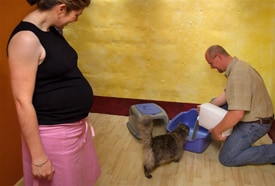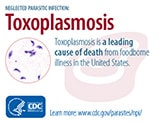Prevention & Control
People who are healthy should follow the guidelines below to reduce risk of toxoplasmosis. If you have a weakened immune system, please see guidelines for Immunocompromised Persons.
Reduce Risk from Food
To prevent risk of toxoplasmosis and other infections from food:
Cook food to safe temperatures. A food thermometer should be used to measure the internal temperature of cooked meat. Color is not a reliable indicator that meat has been cooked to a temperature high enough to kill harmful pathogens like Toxoplasma. Do not sample meat until it is cooked. USDA recommends the following for meat preparation:
For Whole Cuts of Meat (excluding poultry)
Cook to at least 145° F (63° C) as measured with a food thermometer placed in the thickest part of the meat, then allow the meat to rest for three minutes before carving or consuming. *According to USDA, “A ‘rest time’ is the amount of time the product remains at the final temperature, after it has been removed from a grill, oven, or other heat source. During the three minutes after meat is removed from the heat source, its temperature remains constant or continues to rise, which destroys pathogens.”
For Ground Meat (excluding poultry)
Cook to at least 160° F (71° C); ground meats do not require a rest time.
For All Poultry (whole cuts and ground)
Cook to at least 165° F (74° C). The internal temperature should be checked in the innermost part of the thigh, innermost part of the wing, and the thickest part of the breast. Poultry do not require a rest time.
More on: Fight BAC: Safe Food HandlingExternal
- Freeze meat for several days at sub-zero (0° F) temperatures before cooking to greatly reduce chance of infection. *Freezing does not reliably kill other parasites that may be found in meat (like certain species of Trichinella) or harmful bacteria. Cooking meat to USDA recommended internal temperatures is the safest method to destroy all parasites and other pathogens.
- Peel or wash fruits and vegetables thoroughly before eating.

Wash counter tops carefully. Photo courtesy of USDA.
- Wash cutting boards, dishes, counters, utensils, and hands with soapy water after contact with raw meat, poultry, seafood, or unwashed fruits or vegetables.
- Do not drink unpasteurized goat’s milk.
- Do not eat raw or undercooked oysters, mussels, or clams (these may be contaminated with Toxoplasma that has washed into seawater).
More on: Handwashing
The U.S. Government and the meat industry continue their efforts to reduce T. gondii in meat.
Reduce Risk from the Environment
To reduce risk of toxoplasmosis from the environment:
- Avoid drinking untreated water.
- Wear gloves when gardening and during any contact with soil or sand because it might be contaminated with cat feces that contain Toxoplasma. Wash hands with soap and water after gardening or contact with soil or sand.
- Teach children the importance of washing hands to prevent infection.
- Keep outdoor sandboxes covered.

Have someone else clean the litter box. (CDC Photo)
- Feed cats only canned or dried commercial food or well-cooked table food, not raw or undercooked meats.
- Ensure that the cat litter box is changed daily. The Toxoplasma parasite does not become infectious until 1 to 5 days after it is shed in a cat’s feces.
- If you are pregnant or immunocompromised:
- Avoid changing cat litter if possible. If no one else can perform the task, wear disposable gloves and wash your hands with soap and water afterwards.
- Keep cats indoors to prevent them from hunting and reduce the chances they will become infected with Toxoplasma.
- Do not adopt or handle stray cats, especially kittens. Do not get a new cat while you are pregnant or immunocompromised..
